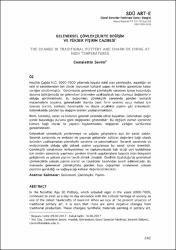| dc.contributor.author | Sevim, Cemalettin | |
| dc.date.accessioned | 2019-10-20T19:32:20Z | |
| dc.date.available | 2019-10-20T19:32:20Z | |
| dc.date.issued | 2017 | |
| dc.identifier.uri | http://www.trdizin.gov.tr/publication/paper/detail/TWpNeE5EUTRPQT09 | |
| dc.identifier.uri | https://hdl.handle.net/11421/18425 | |
| dc.description.abstract | Neolitik Çağda M.Ö. 6000-7000 yıllarında hayata dahil olan çömlekçilik, insanlığın en eski el sanatlarından biri olarak toplumun kültürel yapısı ile birlikte günümüze kadar varlığını sürdürmüştür. Günümüzde geleneksel çömlekçilik sanatının içinde bulunduğu duruma baktığımızda ise geleneksel üretimden uzaklaşılarak bazı olumsuz değişimlerin olduğu görülmektedir. Bu değişimler; çömlekçilik sanatında görülen sentetik malzemelerle boyama, gelenekselin dışında basit form üretimi, ucuz maliyet için özensiz üretim, kalitesiz hammadde ve düşük sıcaklıkta pişirim gibi etkenlerdir. Gelenekselde görülen bu değişim üretimi yozlaştırmaktadır. Bilim, teknoloji, sanat ve kültürün gelenek üzerinde etkisi büyüktür. Geleneksel, çağın içinde bulunduğu duruma göre değişkenlik gösterebilir. Bu değişim zaman içerisinde kültüre bağlı olarak öz yapısını kaybetmeden, değişerek varlığını sürdürmesi gerekmektedir. Geleneksel çömlekçilik yenilenmeye ve çağdaş gelişmelere açık bir sanat dalıdır. Seramik sanatında ve endüstri de yaşanan gelişmeler kültürel değerlere bağlı olarak özünden uzaklaşmadan çömlekçilik sanatına da yansımaktadır. Seramik sanatında ve endüstrisinde olduğu gibi yüksek pişirim uygulaması bu sanat içinde önemlidir. Çömlekçilik sanatımızın ilerleyebilmesi ve toplumumuzda hak ettiği yeri bulabilmesi için üretim sürecinde yapılması gereken önemli uygulamaların başında ürün bünyesini geliştirmek ve yüksek pişirim tercih etmek olmalıdır. Özellikle Uzakdoğu'da geleneksel çömlekçilikte yüksek pişirim üretici ve tüketiciler tarafından tercih edilmektedir. Bu makalede geleneksel çömlekçilikte görülen bazı değişimler incelenerek yüksek pişirimin gerekliliği ve sağlayacağı katkılar değerlendirilecektir. | en_US |
| dc.description.abstract | In the Neolithic Age BC Pottery, which included vigor in the years 6000-7000, continued to exist as a day-to-day existence with the cultural heritage of society as one of the oldest handicrafts of mankind. When we look at the present situation of traditional pottery art, it is seen that there are some negative changes from traditional production. These changes; Synthetic materials painting in pottery art, simple form production other than traditional, sloppy production for cheap cost, poor quality raw material and low temperature firing. This change, traditionally seen, corrupts production. Science, technology, art and culture are great influences on tradition. Traditional, may vary according to the situation in the age. This change must continue to change over time, without losing its self-structure depending on the culture. Traditional pottery is an art form that is open to renewing and contemporary developments. The developments experienced in ceramic art and industry are also reflected in the art of pottery, without moving away from the essence depending on cultural values. The application of high-firing as in ceramic art and in industry is important in this art. In order for our pottery art to move forward and find its rightful place in our society, it should be at the beginning of the important applications to be made in the production process, to improve the product line and to prefer high purity. Especially in the Far East traditional frying is preferred by producers and consumers. In this article, some changes in traditional pottery will be examined and the necessity of high firing will be assessed. | en_US |
| dc.language.iso | tur | en_US |
| dc.rights | info:eu-repo/semantics/openAccess | en_US |
| dc.subject | Sanat | en_US |
| dc.title | Geleneksel Çömlekçilikte Değişim ve Yüksek Pişirim Cazibesi | en_US |
| dc.title.alternative | The Change in Traditional Pottery and Charm of Firing at High Temperatures | en_US |
| dc.type | article | en_US |
| dc.relation.journal | Art-e Sanat Dergisi | en_US |
| dc.contributor.department | Anadolu Üniversitesi, Güzel Sanatlar Fakültesi, Seramik Bölümü | en_US |
| dc.identifier.volume | 10 | en_US |
| dc.identifier.issue | 19 | en_US |
| dc.identifier.startpage | 242 | en_US |
| dc.identifier.endpage | 251 | en_US |
| dc.relation.publicationcategory | Makale - Ulusal Hakemli Dergi - Kurum Öğretim Elemanı | en_US] |


















